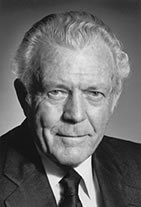About
In Memoriam: John R. Whinnery,
Feb 01, 2009
In memoriam: John R. Whinnery, 1916-2009
 |
| Peg Skorpinski photo |
John Roy Whinnery, an OSA Fellow who was an innovator in the field of electromagnetism and communication electronics, died February 1, 2009, at his home in Walnut Creek, California. He was 92.
Whinnery received both his BS and PhD degrees in Electrical Engineering from the University of California, Berkeley, in 1937 and 1948, respectively. From 1937-1946, he was with the General Electric Company in Schenectady, New York, working on problems in waveguide discontinuities, microwave tubes, and applications to radar, which also aided the war effort. Upon returning to Berkeley in 1946, Whinnery joined the faculty as a Lecturer and, upon completion of his doctorate, became first an Associate Professor and then a Full Professor. During his long tenure at the university, Whinnery held a number of leadership positions, including director of the Electronics Research Laboratory (1952-1956), chairman of the Department of Electrical Engineering (1956-1959), and dean of the College of Engineering (1959-1963). He retired as Professor Emeritus in 1987.
During leaves from the university, Whinnery held positions as head of the Microwave Tube Research Division of the Hughes Aircraft Company (1951-1952), participated in research in quantum electronics at Bell Laboratories in New Jersey (1963 -1964), and held visiting professorships at the University of California Santa Cruz and Stanford University. In 1959, he held a Guggenheim Fellowship at the Swiss Federal Institute of Technology (ETH Zurich).
Whinnery's earliest work focused on understanding discontinuities in electromagnetic wave devices. His research led to innovations in microwave amplifiers such as triodes, used in World War II communication devices and radar receivers, and in traveling-wave tubes, including the backward-wave amplifier, which is still used in radar and satellite communications.
He later became interested in the emerging field of lasers and laser applications in communications. He and his students produced advances in ultra-short optical pulses, which can be used to study fast processes in materials and chemical reactions. He was recognized as one of the country's top experts on the fundamentals of quantum electronics.
In addition to his research, Whinnery is widely credited with helping to bring the study of applied electromagnetic theory to a broader audience with the pioneering textbook, Fields and Waves in Modern Radio, which he co-authored with Simon Ramo in 1944.
In 1992, Whinnery's research contributions, excellence as an educator and record of service earned him the National Medal of Science, the nation's highest scientific honor bestowed by the president. He was the recipient of many other awards and honors, including the Founder's Award of the National Academy of Engineering, the Medal of Honor of the Institute of Electrical and Electronics Engineers, the Lamme Medal of the American Society for Engineering Education, the Berkeley Citation and the Distinguished Engineering Alumnus Award. He also earned the uncommon distinction of being elected to both the National Academy of Sciences and the National Academy of Engineering, and he served on NASA's Science and Technology Committee on Manned Space Flight for the Apollo Space Program. Whinnery earned a national reputation in matters of engineering education and played a key role in the creation of the Commission on Engineering Education. In 1994, the John R. Whinnery Chair in Electrical Engineering and Computer Sciences was established at Berkeley.
Whinnery was known for his love of writing poetry and children's stories, cultivating fine wines, and hiking in the mountains. His friends also noted that he was an enthusiastic, but “challenged,” golfer.
Whinnery was preceded in death in 2007 by Patricia, his wife of 63 years. He is survived by three daughters and three granddaughters.
